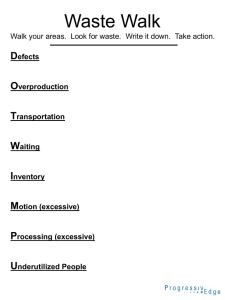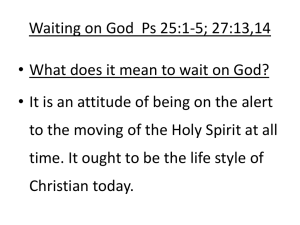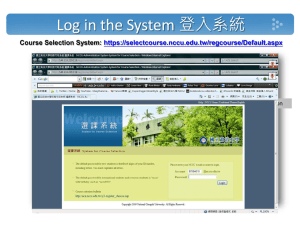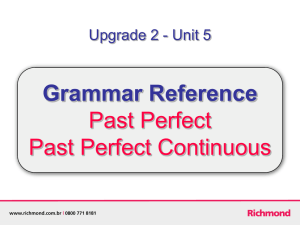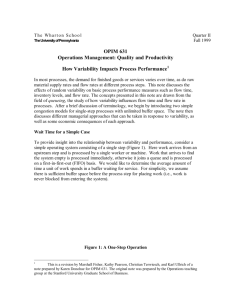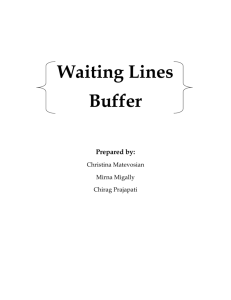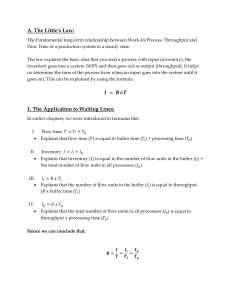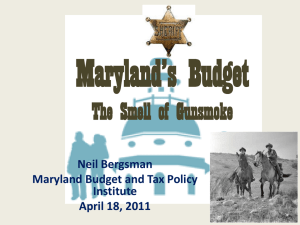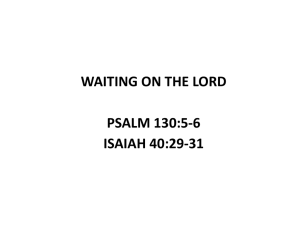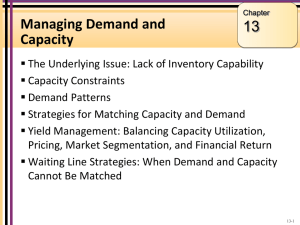CT 7
advertisement
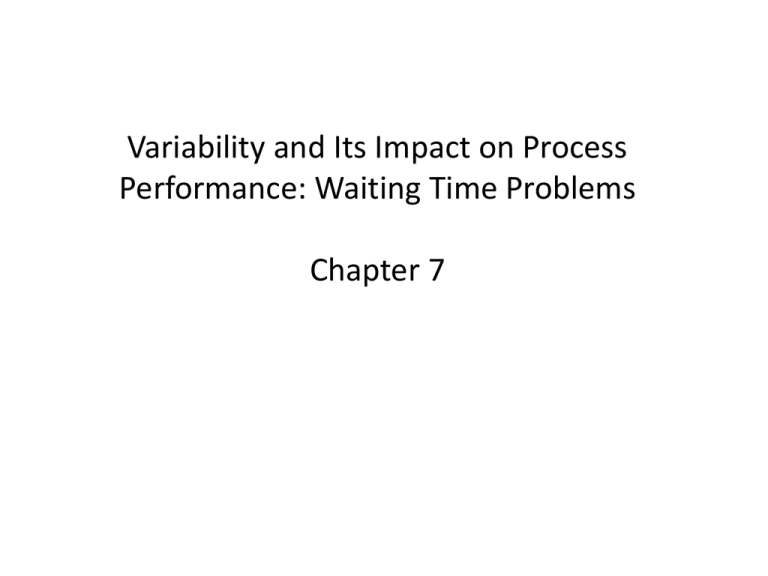
Variability and Its Impact on Process
Performance: Waiting Time Problems
Chapter 7
A Somewhat Odd Service Process (Chapters 1-6)
Patient Arrival Service
Time Time
1
2
3
4
5
6
7
8
9
10
11
12
0
5
10
15
20
25
30
35
40
45
50
55
4
4
4
4
4
4
4
4
4
4
4
4
7:00
7:10
7:20
7:30
7:40
7:50
8:00
A More Realistic Service Process
Patient 1 Patient 3 Patient 5 Patient 7
1
2
3
4
5
6
7
8
9
10
11
12
0
7
9
12
18
22
25
30
36
45
51
55
5
6
7
6
5
2
4
3
4
2
2
3
Patient 2 Patient 4 Patient 6 Patient 8
Patient 11
Patient 10
Patient 12
Time
7:00
7:10
7:20
7:30
7:40
7:50
3
Number of cases
Arrival Service
Patient Time
Time
Patient 9
2
1
0
2 min. 3 min. 4 min. 5 min. 6 min. 7 min.
Service times
8:00
Variability Leads to Waiting Time
Pt
1
2
3
4
5
6
7
8
9
10
11
12
Arrival
Time
0
7
9
12
18
22
25
30
36
45
51
55
p
5
6
7
6
5
2
4
3
4
2
2
3
Service time
Wait time
7:00
7:10
7:20
7:30
7:40
7:50
8:00
7:00
7:10
7:20
7:30
7:40
7:50
8:00
5
4
3
Inventory
(Patients at lab)
2
1
0
Sources of Variability
Buffer
Processing
The “Memoryless” Exponential Function
• Interarrival times follow an exponential distribution
P{IA t} 1 e
t
a
• Exponential interarrival times = Poisson arrival process
• Coefficient of Variation (CV )
CV
Quite possibly the worst run of three
slides you will see this semester
Waiting Time
Flow rate
Inventory
waiting Iq
Inventory
In process Ip
Inflow
Outflow
Entry to system
Average flow time T
Increasing
Variability
Begin Service Departure
Time in queue Tq
Service Time p
Total Flow Time T=Tq+p
Theoretical Flow Time
Utilization
100%
A Waiting Time Formula
CVa2 CVp2
utilization
Time in queue Activity Time
2
1 utilization
Service time factor
Utilization factor
Variability factor
Waiting Time for Multiple, Parallel Resources
Inventory
in service Ip
Inflow
Inventory
waiting Iq
Entry to system
Outflow
Begin Service
Time in queue Tq
Flow rate
Departure
Service Time p
Total Flow Time T=Tq+p
The Waiting Time Formula for Multiple (m) Servers
2 ( m 1) 1
CVa2 CV p2
Activity tim e utilization
Tim ein queue
m
2
1 utilization
Summary of Queuing Analysis
Utilization
Flow unit
u
Server
Inventory
in service Ip
1
a p
am
m 1
p
Time related measures
2 ( m 1) 1
CVa2 CV p2
Activity tim e utilization
Tim ein queue
m
1
utilizatio
n
2
Outflow
Inflow
T Tq p
Inventory
waiting Iq
Inventory related measures
Entry to
system
Begin
Service
Waiting Time Tq
Departure
Service Time p
Flow Time T=Tq+p
Iq
Tq
a
I p um
I I p Iq
7.2 E-mails arrive to My-Law.com from 8 a.m. to 6 p.m. at a rate of 10 emails per hour (cv=1). At each moment in time, there is exactly one
lawyer “on call” waiting these e-mails. It takes on average five minutes
to respond with a standard deviation of four minutes.
a. What is the average time a customer must wait for a response?
b. How many e-mails will a lawyer receive at the end of the day?
c. When not responding to e-mails, the lawyer is encouraged to actively
pursue cases that potentially could lead to large settlements. How
much time during a ten hour shift can be devoted to this pursuit?
To increase responsiveness of the system, a template will be used for most
e-mail responses. The standard deviation for writing the response now
drops to 0.5 minutes but the average writing time is unchanged.
d.
e.
Now how much time can a lawyer spend pursuing cases?
How long does a customer have to wait for a response to an inquiry?
Service Levels in Waiting Systems
Fraction of
1
customers who
have to wait x 0.8
seconds or less
90% of calls had
to wait 25
seconds or less
Waiting times for those customers
who do not get served immediately
0.6
0.4
Fraction of customers who get
served without waiting at all
0.2
0
0
50
100
150
Waiting time [seconds]
• Target Wait Time (TWT)
• Service Level = Probability{Waiting TimeTWT}
• Example: Deutsche Bundesbahn Call Center
- now (2003): 30% of calls answered within 20 seconds
- target: 80% of calls answered within 20 seconds
200
Data in Practical Call Center Setting
Number of customers
Per 15 minutes
Distribution Function
1
160
140
120
100
80
60
40
20
0
0.8
Exponential distribution
0.6
0:01:09
0:01:00
0:00:52
0:00:43
0:00:35
0:00:26
Time
0:00:17
0:15
2:00
3:45
5:30
7:15
9:00
10:45
12:30
14:15
16:00
17:45
19:30
21:15
23:00
0
0:00:00
0.2
0:00:09
Empirical distribution
(individual points)
0.4
The Power of Pooling
Independent Resources
2x(m=1)
Waiting
Time Tq
70.00
60.00
m=1
50.00
40.00
- OR Pooled Resources
(m=2)
30.00
20.00
10.00
m=2
m=5
m=10
0.00 60% 65% 70%75%80%85% 90% 95%
Utilization u
Priority Rules in Waiting Time Systems
Service times:
A: 9 minutes
B: 10 minutes
C: 4 minutes
D: 8 minutes
C
A
9 min.
19 min.
4 min.
B
13 min.
C
23 min.
D
Total wait time: 9+19+23=51min
•SPT
•FCFS
•EDD
•Priority
•WNIFOARB
D
21 min.
A
B
Total wait time: 4+13+21=38 min
7.3The airport branch of a car rental company maintains a fleet of 50 SUVs.
The interarrival time between requests for an SUV is 2.4 hours with a
standard deviation of 2.4 hours. Assume that, if all SUVs are rented,
customers are willing to wait until an SUV is available. An SUV is rented, on
average for 3 days, with a standard deviation of 1 day.
What is the average number of SUVs in the company lot?
What is the average time a customer has to wait to rent an SUV?
The company discovers that if it reduces its daily $80 rental price by $25, the
average demand would increase to 12 rentals per day and the average
rental duration will become 4 days. Should they go for it?
How would the waiting time change if the company decides to limit all SUV
rentals to exactly 4 days? Assume that if such a restriction is imposed, the
average interarrival time will increase to 3 hours as will the std deviation.
